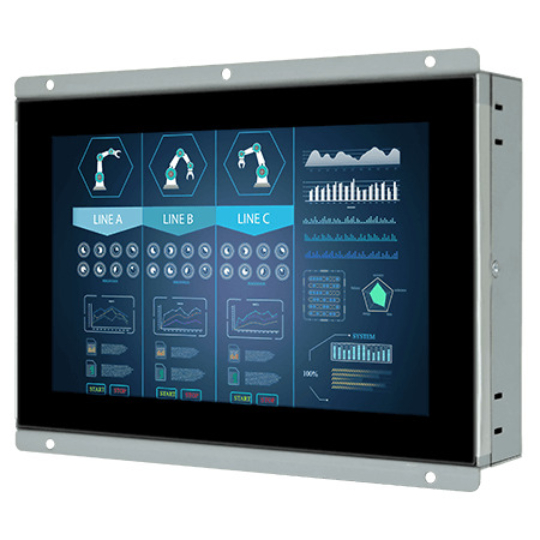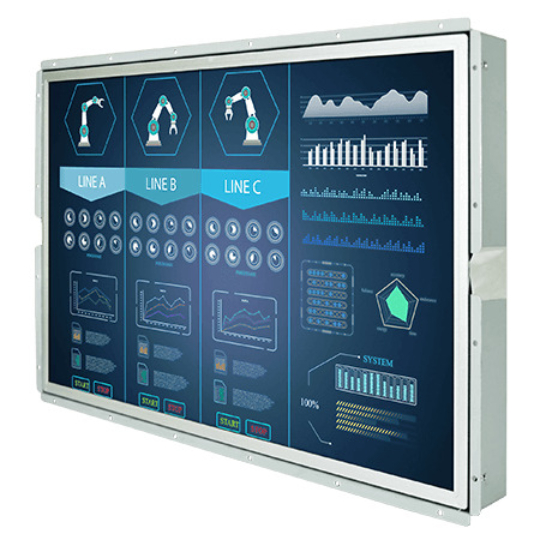Benefits of Open Frame Displays vs Embedded LCD Display Kits
Things Embedded works with machine builders and OEMs throughout the USA providing support for a wide range of embedded displays and single board computers integrated into their product.
Some of our customer’s particular applications require frameless monitors that may need to be integrated into confined spaces. For this, we offer both embedded displays and industrial open frame displays alongside a wide range of SBCs and embedded box PCs to meet your requirements on driving content to the display.
Whereby embedded LCD display kits provide a space-saving form factor with reduced cost, an open-frame LCD monitor offers the same frameless benefits whilst simplifying integration and pairing with your chosen SBC through standardized plug-and-play display ports. With plenty of options on the market, this article defines what an open frame display is along with a few key specifications to look out for.
What is an Open Frame Monitor?
An open-frame monitor is a display that is integrated into a bare metal chassis without an enclosure or bezel. An advantage of an open frame monitor is the flexible design which allows it to be integrated into a wide range of applications whilst offering a custom aesthetic for the end user. They can easily be installed into existing equipment or structural housings with open apertures. A distinct advantage to using an open frame LCD display vs an embedded LCD display kit is the versatile mounting options the chassis’ offers by including both a rear and VESA mounting pattern. This allows the end customer to choose the most appropriate mounting option for the application it will be used in.
Open-frame LCD monitors are used in a wide range of commercial and industrial industries like point-of-sale, surveillance systems, ATM machines, vending machines, self-service kiosks, industrial automation plants, POS systems, food processing plants, and manufacturing facilities.
Industrial Grade Open Frame Displays

USB Type C Open Frame Monitors
Open Frame Display Features
Sizes of open frame LCD monitors vary from screens as small as 5.7” with large format versions available, 27” and 32” being very popular. These are available in different industry-standard display resolutions in both standard widescreen formats. The latest high-resolution standards include 1920x1080p FHD, 2K, and 4K Ultra HD, which tend to be more popular in retail and digital signage applications where content is king.
An open-frame LCD display has individual pixels that are arranged in a rectangular grid. Each grid has an RGB (Red, Green, Blue) sub-pixel which can be turned on or off. When all the sub-pixels are turned off the display appears black whereas when all the sub-pixels are turned on 100%, the screen appears white. Adjusting individual levels of red, green, and blue light offers millions of color combination possibilities.
Integrating Touch Overlays to Create Open Frame Touch Displays
Open frame monitors can also be preconfigured with various touch overlays to meet the operators’ specific requirements. The most common open-frame touch displays include either a resistive or PCAP touch overlay, with PCAP being the most common.
Resistive touch technology can be activated with any object such your finger, stylus, or glove. Where the operator is using a thick glove which doesn’t have capacitive properties resistive touch technology is a must.
Projected Capacitive Touch Technology (PCAP) has overtaken Resistive as the dominant global touch technology. This technology relies upon a conductive object interacting with the charge carried by the screen. A primary benefit to PCAP technology is support for Multi Touch operation whereby a user can operate the display with up to 10 touch points, ideal for navigating the graphical user interface (GUI) with ease.
Learn more about different touch types and choosing the right touch technology for your industrial display.
Sunlight Readability with Wide Operating Temperature Support
Open frame LCD monitors are not only suitable for indoor applications but can be integrated outdoors too. High ambient light levels typically cause difficulties for viewing content on displays unless high bright backlights are applied. High bright sunlight readable open frame displays should be chosen for integration in high ambient light environments such as in-window or outdoor applications.
A basic marker for choosing a suitable outdoor open frame display would be supporting a minimum 1,000-nit backlight display and wide operating temperature components. Click the link to read more about key features when choosing a sunlight readable display.
Low Power Draw with LED Backlighting
A key figure to not be overlooked is the display’s power draw. Most displays are now designed with efficient LED backlights for low power consumption and effective heat dissipation. This makes the displays durable for long-term usage in the industrial and retail industries whilst also offering a lower carbon footprint when it comes to power. The USB Type-C open frame displays offer a new generation of products that takes convenience to the next level. With just a single USB Type-C cable, you can easily power smaller open frame displays up to 15.6″ in size.
For ultimate energy efficiency, E Ink displays should be explored. This new display standard offers many benefits aside from low power draw including image clarity with high pixel density and support for sunlight readability without the need for a backlight. These new displays on the market are also available with rear-mount open frame chassis.
Need Help Choosing an Open Frame Display?
Tell us about your application and a member of our team will get right back to you.

